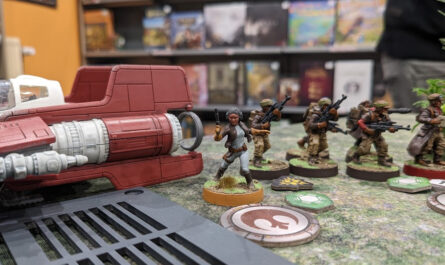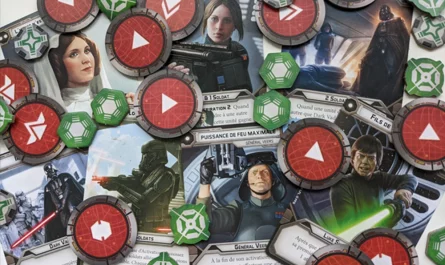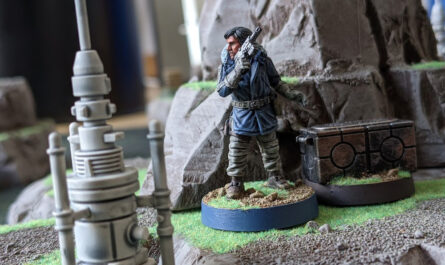In Star Wars: Legion, units have several slots for upgrade cards. Often used to spend a few leftover points or copy a high-performing list, many players don’t fully grasp the impact these mini cards can have on the game. Some of us wonder: is this good equipment? Which upgrade goes with which unit? Should you load your units with gear? Or on the contrary, is it okay to run a unit with no upgrades at all? To answer these questions, you need to understand the role of an upgrade card and how cost-effective it can be. It’s a tricky exercise for newcomers. But by asking the right questions, it becomes accessible to everyone. In this article, I’ll show you how to read between the lines on your mini cards so you never have to fly blind again.
The process of evaluating an upgrade card
The four steps below will help you assess the usefulness of an upgrade card for your unit. To illustrate my points, I’ll walk through the process using these seven upgrades:
- Recon Intel
- Duck and Cover
- Smoke Grenades
- Targeting Scopes
- HQ Uplink
- Prepared Supplies
- Offensive Push
Evaluate the impact against a firing squad
Imagine a theoretical “turn zero” in which your opponent has initiative. They are allowed to perform a ranged attack against one of your units, which is out in the open with no cover. In other words, you’re facing a firing squad, and your unit is at serious risk of being wiped out. In this exercise, the goal is to evaluate the value of an upgrade by answering two key questions:
- Is the upgrade useful against the firing squad?
- If your unit is wiped out by this attack, did the upgrade at least pay for itself?
Targeting Scopes and Offensive Push are no help on defense. If your troops go down, the points spent on those upgrades are wasted. The same goes for Smoke Grenades: they could have improved your cover, but without initiative, you can’t use them in time.
HQ Uplink and Recon Intel don’t help you defend either. However, they are still cost-effective. The former can be triggered at the end of the Command Phase, while the latter activates immediately upon deployment. In other words, they can provide value even before the firing squad opens fire. So even if your unit is eliminated in the attack, you’re unlikely to have wasted those points. For example, HQ Uplink may have triggered a Coordinate effect, while Recon Intel may have helped you deploy a “daughter” unit with the Detachment keyword well outside your starting zone. (If you’re not familiar with this trick, here’s an example: assign Recon Intel to Rebel Veterans. When they deploy, they can perform a speed-1 move thanks to the upgrade. Later, when you deploy the Mark II Medium Blaster Trooper, it must be placed within cohesion range of the Veterans—i.e., speed-1 distance. So in the end, the Mark II can be deployed effectively two speed-1 moves away from your deployment zone!)
The big winners in this exercise are Duck and Cover and Prepared Supplies. These upgrades are useful when faced with a firing squad: they can either increase the unit’s cover or cancel a hit. The chances of them paying off are high (but not perfect, given that no-one is safe from a dice roll containing only critical hits).
⭐ Key takeaways
For fragile units, i.e. those defending with white dice, favour upgrades that pass the firing squad test. You’ll have a better chance of getting the most out of their equipment. If you opt for 0 risk, then it’s better not to equip them at all! For more robust units, their chances of survival are higher and they will be able to take advantage of their upgrades later on. You therefore have greater freedom in the choice of equipment you allocate to them.
Assess the requirements for its operation
- Do I need any particular conditions or actions to trigger the card’s effect?
- If so, do I have control over these conditions or actions?
- Are these conditions rare or frequent? Are they unavoidable?
Targeting Scopes and Offensive Push require another action from you to work: without a green token, Targeting Scopes are useless. Without a move, Offensive Push cannot be activated. These cards therefore imply that the equipped unit must be able to carry out these actions (or receive the appropriate token). Are these actions part of your strategy? For example, if you intend to immobilise your snipers during the whole game, Offensive Push will not be a smart option.

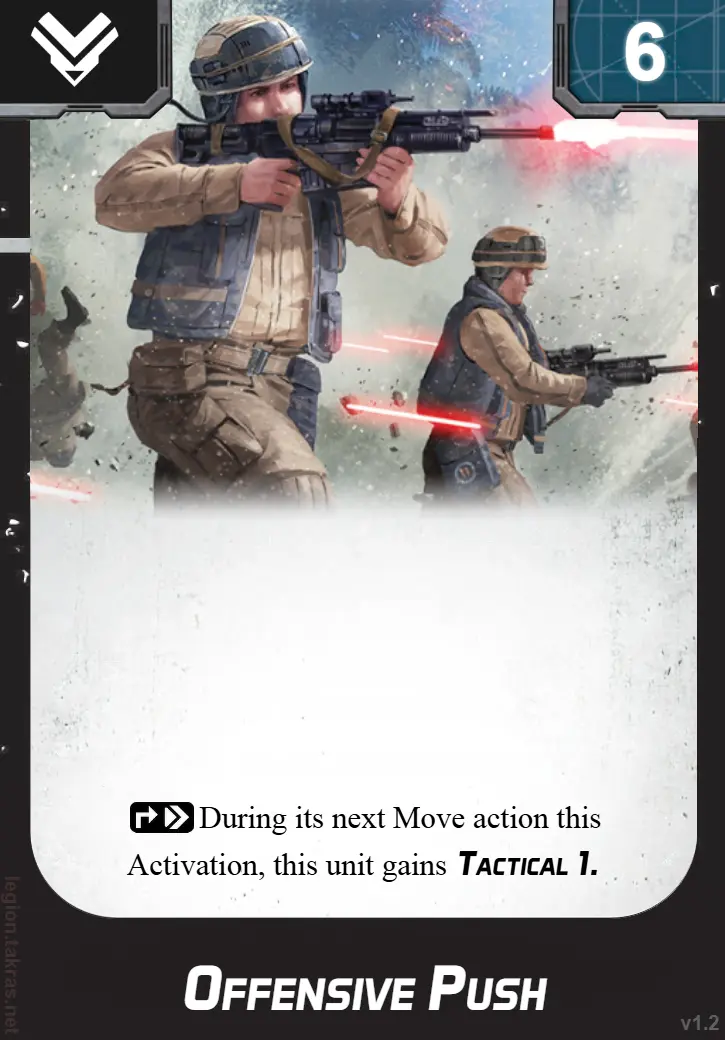
Although Prepared Supplies, Duck and Cover and Smoke Grenades don’t require you to take any action as such, you are dependent on a situation that you don’t (quite) control. You can’t activate the card’s effects whenever you like. The first two require an enemy attack while the second, although free, requires the unit to activate beforehand.
Finally, with Recon Intel and HQ Uplink you are in control of the situation: you are not dependent on any other game effect to benefit from it.
⭐ Key takeaways
If you prefer to set the pace for your opponent, favour upgrades with effects you can control. However, as your opponent’s attacks are frequent, upgrades such as Prepared Supplies and Duck and Cover will rarely be wasted. On the other hand, I’d advise you to reduce the number of upgrades that require an action on your part, at the risk of handcuffing yourself during the game. It will reduce your options and in the end give your opponent some virtual action advantage.
Single use or not?
Recon Intel, Prepared Supplies and Smoke Grenades upgrades are single-use. They require some planning on your part: before the game starts, you should have identified the situation or the moment during which you will use their ability. There’s no room for improvisation if you don’t want to waste those points.


Targeting Scopes and Duck and Cover upgrades are multi-purpose. To get the most out of them, you need to use their abilities as often as possible during the game. Note however that Duck and Cover requires you to use its ability sparingly, at the risk of drowning your unit under suppression tokens.
Other upgrades are halfway between single use and multiple use: tapped cards. Each use has a serious cost: performing a Recover action. This is the case for HQ Uplink and Offensive Push.
⭐ Key takeaways
Multi-use cards are attractive. To make the most of them be sure to use them to the full. However, if your unit can’t afford a Recover action because it has other things to worry about, don’t dwell on this type of upgrade. As for single-use upgrades, they need planning to shine. Think about the cross-cutting strategy of your list and assess whether they can contribute to it.
Look for the soul mate (if there is one)
Whether through other mini-cards or other keywords, the combination of upgrades can be worth much more than the sum of their respective values! This is the case for example with Prepared Supplies when paired with Situational Awareness. Together, these cards ensure that you cancel at least one hit, critical or normal hit, as long as no enemy effect forbid you to use a dodge token.


- HQ Uplink works well with keywords that require an order to launch their effects, such as Defend X, Coordinate or Fire Support to name a few.
- Duck and Cover work well with Danger Sense and Low Profile abilities. Smoke grenades also work well with the latter ability.
- The Precise 1 keyword from the Targeting Scopes stacks with other instances of Precise X, giving you Precise X+1. Same goes for Intel Recon and Scout X.
- Offensive Push doesn’t seem to have found its soulmate (yet) but only a few companions in the form of Precise X, Marksman, Lethal X or Duelist.
⭐ Key takeaways
By combining the right keywords, you can generate combos. Combos are powerful because their effects are greater than the sum of their parts. Your list will be worth virtually more than 600 or 1,000 points. But beware, combos are double-edged: Separated from each other, these upgrades perform much less well on their own.
FAQ
Which upgrade for which unit?
To answer this question, you first need to ask yourself what your strategy is with your army. Are you looking to crush your opponent? Do you prefer to play objectives? Do you have a specific tactic like this list based on suppression? By finding the answers to these questions, you will gradually build up the profile of your units needed to fulfil your mission. However, I’d like to draw your attention to the following points:
Check upgrade compatibility (beyond the slot)
Just because a unit has an equipment slot doesn’t necessarily mean it will make good use of it. Sometimes appearances can be deceiving indeed. You think you’ve found the perfect upgrade for a unit, but the reality on the ground shows you otherwise. This is the case, for example, with Stormtroopers and the Scopes upgrade. Thanks to this combination, the soldiers benefit from the Accuracy 2 ability, which may well appeal to you. This will allow them to re-roll four dice when they spend an Aiming token. Unfortunately if your Storms only form a quartet, the chances of you having to re-roll 4 attack dice are slim. Worse: if you lose a soldier, the most you’ll be able to do is re-roll 3 dice meaning you would have paid for unnecessary upgrade. On the other hand, if you add a heavy weapon that adds a large number of dice to your dice pool, you come out on top.

⭐ Key takeaways
Consider the performance of an upgrade during the life of your unit: how does it perform when the unit is at full strength? When it starts losing soldiers? And finally, when it’s crumbling under suppression tokens?
Is it acceptable to play with vanilla units?
Yes and the best proof is Tza‘s list containing 7 vanilla units out of 10 ! Tza is a double time France Champion (2022 & 2023). See his winning list below, played during France’s Championship 2022 (128 players).
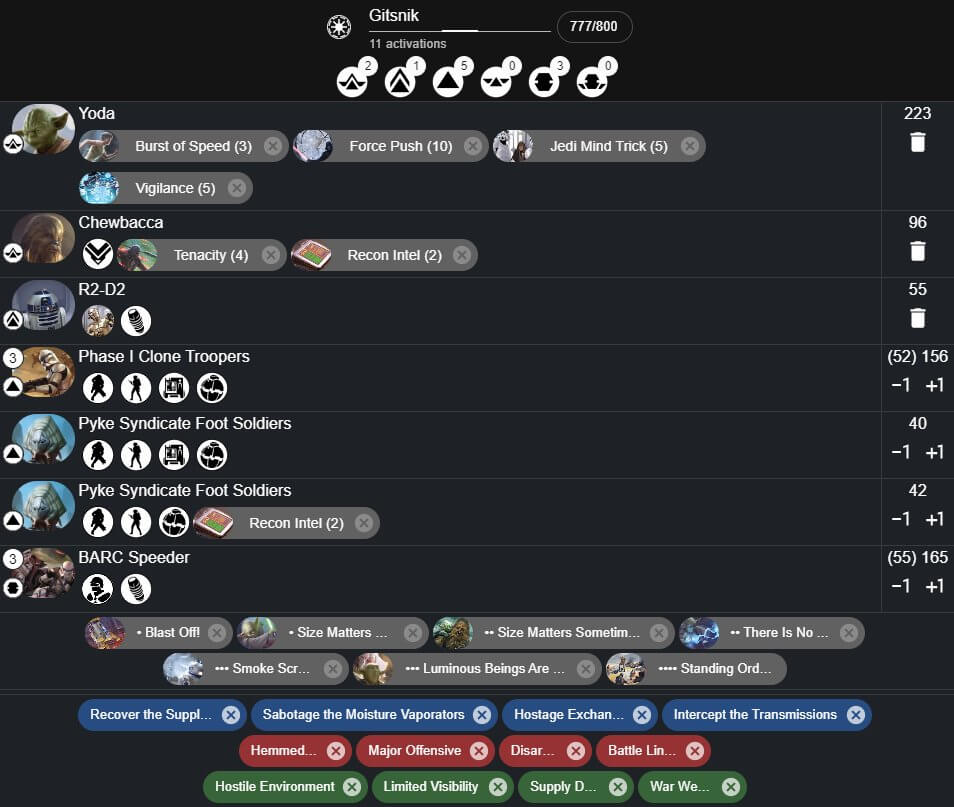
Should units be over-equipped?
Yes and no. It’s a case-by-case decision. Some units are too weak ‘vanilla’ and a series of upgrades make them much more threatening. This is the case with Rebel Troopers when they are equipped in this way:

However, you need to be able to weigh up the pros and cons of such a choice. Every point spent on this type of unit is not spent elsewhere. So you have to be sure that the cost is worth it. The illustration that comes to mind is none other than a personal experience with my Rebel Pathfinders. During a match against Enguerrand, I proudly deployed this special unit high up thanks to their Infiltration keyword. Probably too high… The first activation of the game was for my opponent. His CRA Soldiers launched the assault and made short work of my poor Surveyors. Even before my first activation, I’d lost almost 100 unit points. In other words, I started the game with 700 points against his 800 points…
Conclusion
What can I say, except that the upgrades are legion (badum tsss)? I hope that Atomic Mass Games plans to release many more. After all, upgrades play an important role in metagames over time. They can completely change the way you approach a unit and extend the replayability of Star Wars: Legion. It’s therefore essential to understand them better in order to improve your gaming experience. I hope I’ve given you the keys to improving your army lists so that you too can produce lists worthy of champions.
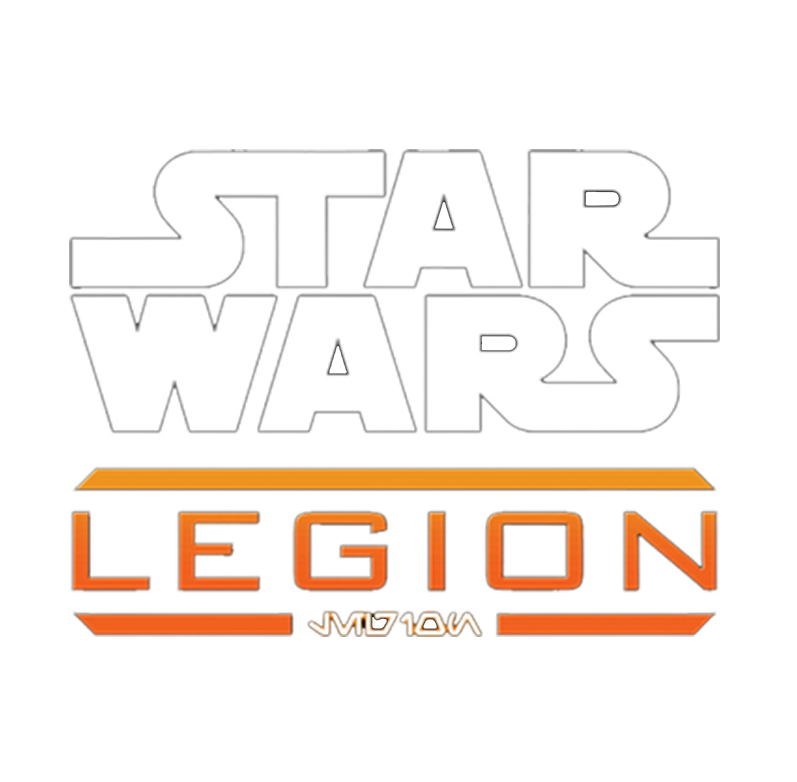
Find Star Wars: Legion players
Join your country’s SWL Discord community and connect with players nearby.

